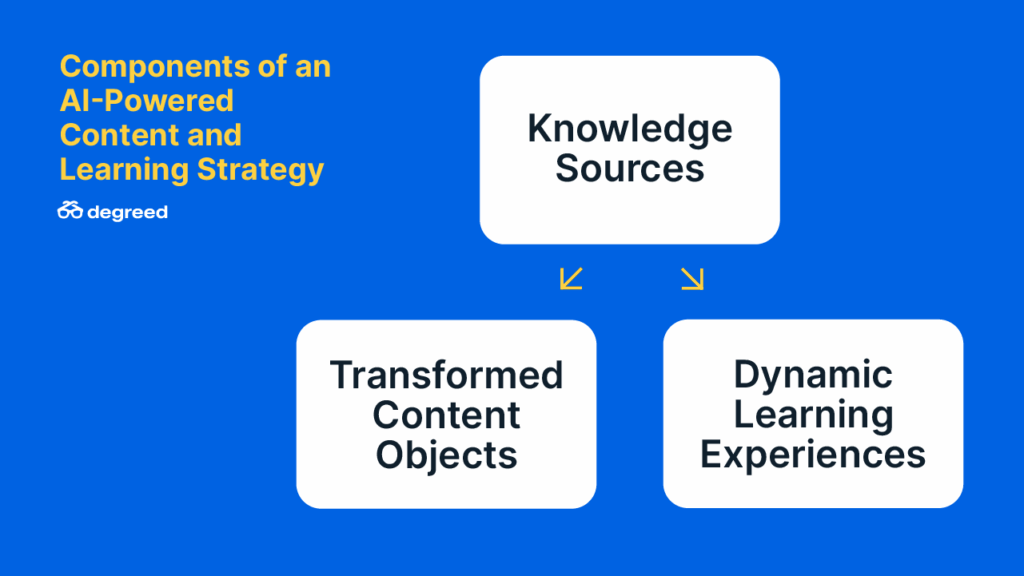
Add AI into your Content and Learning Strategy
L&D has always been about more than content or any specific modality. At its core, learning strategy should drive business impact—with learning resources and experiences as tools to achieve that goal.
In Degreed’s AI Experiments Lab, we are using AI as an opportunity to reimagine learning content. With it, we can invest in adaptive, efficient, and effective approaches that deliver better outcomes for both employees and organizations.
The Old Way to Tackle Learning Content
Traditionally, L&D, HR, and talent professionals created, curated, or purchased content (often in the form of courses) and tried to make it available where and when people needed it.
That content strategy was linear, resource-intensive, and often missed the mark on personalization and timeliness.
The New Way to Enhance Learning Strategy
Today, AI-enabled tools and chatbots are redefining how we access and consume content. Here’s how to break down three components that will help you build an AI-powered content and learning strategy: Knowledge Sources, Transformed Content Objects, and Dynamic Learning Experiences.
1. Knowledge Sources
Knowledge sources are the foundational layer for all modern AI-powered learning strategies. They are the source of truth that everything is built from. Knowledge sources can include:
- Dynamic data from web sources: Real-time updates pulled from the internet or APIs. Useful for recency, but requires filtering and context.
- Model training data: Broad, pre-learned information from public sources. Useful for general knowledge, but may be outdated or lack specificity.
- Licensed content libraries and expert resources: Curated, high-quality materials from trusted vendors or specialists. Offers credibility and narrative depth.
- Internal documentation and proprietary content: Organization-specific materials like manuals, process guides, and internal wikis. Highly relevant, but often fragmented or out of date.
Together, these sources form the raw material that fuels both transformed content and dynamic experiences.
2. Transformed Content Objects
Transformed content objects are structured learning assets created by reformatting knowledge sources into polished, reusable formats. These are especially effective when you want to take dense or complex source material and deliver it in more accessible, engaging forms that can be reused and shared across teams.
Examples include:
- Slide decks
- Explainer videos
- Infographics
- One-pagers and job aids
- Audio summaries or podcasts
Best suited for:
- Topics requiring human oversight or approval
- Scenarios where consistent messaging and branding matter
- Creating multimedia formats that require more time, specialized skills, or budget to produce
Most importantly, transformed content objects allow for a layer of editorial control and customization that ensures accuracy and tone. This is ideal when quality, branding, and repeatability matter, making it a core strategy for learning teams seeking scale and consistency.
These assets are pre-built and reviewed, offering clarity, engagement, and control when precision and polish are critical.
3. Dynamic Learning Experiences
Dynamic learning experiences use AI to generate personalized content and interactions in real time, based on the same knowledge sources. Unlike transformed content, these experiences are not reviewed or packaged in advance—they’re created on the fly, adapting to user needs, contexts, and questions.
Examples include:
- Chatbots for Q&A or task support
- Voice assistants for walkthroughs
- Adaptive quizzes and exercises
- Live translation tools
- Scenario-based simulations
Best suited for:
- Situations requiring just-in-time information
- Personalized or context-specific learning
- Flexible delivery without prebuilt content
By adapting in real time to a learner’s role, prior knowledge, behavior, or skills, dynamic experiences can offer uniquely relevant guidance that evolves with the individual. This makes it possible to deliver more meaningful and contextualized support without waiting for traditional course development cycles.
However, it comes with trade-offs: the lack of pre-review means you need strong source content and governance to ensure accuracy, and analytics are often less consistent or structured. Still, when used well, dynamic learning can provide high-impact support that feels more like a conversation than a course.
| AI Content Type | Includes… | Best suited for… |
| Knowledge Sources | • Dynamic data from web sources • Model training data • Licensed content libraries and expert resources • Internal documentation and proprietary content | All AI-driven learning content |
| Transformed Content Objects | • Slide decks • Explainer videos • Infographics • One-pagers and job aids • Audio summaries or podcasts | • Topics requiring human oversight or approval • Scenarios where consistent messaging and branding matter • Creating multimedia formats that require more time, specialized skills, or budget to produce |
| Dynamic Learning Experiences | • Chatbots for Q&A or task support • Voice assistants for walkthroughs • Adaptive quizzes and exercises • Live translation tools • Scenario-based simulations | • Situations requiring just-in-time information • Personalized or context-specific learning • Flexible delivery without prebuilt content |
How Degreed Helps
We’re reshaping what it means to be a Learning Experience Platform (LXP) today by enabling organizations to operationalize each layer of the new content strategy—starting from the source.
1. Activating Knowledge Sources
Degreed integrates with and brings together more learning-oriented knowledge sources than any other system by connecting internal content, licensed libraries, and external data in a unified platform.
Our platform helps ensure your knowledge base is current, credible, and discoverable, so that it serves as a strong foundation for AI-driven experiences. To strengthen the trust and transparency, we’re also building advanced content evaluation and auditing tools to help you assess and validate your knowledge sources.
Prioritizing high-quality inputs improves consistency, accuracy, and the impact of everything that follows.
2. Transforming Content with Control
Degreed supports the creation of polished learning assets through workflows that reformat and enrich your content—turning documents into videos, podcasts, summaries, and more.
In addition, through Degreed Open Library, we provide access to expertly transformed, multi-modal content on the most in-demand topics at no additional cost to our Degreed Learning clients.
These tools empower admins with faster, more flexible creation of engaging learning materials. Whether you’re publishing for onboarding, compliance, or upskilling, you get consistency, oversight, and brand alignment.
3. Delivering Dynamic Learning Experiences
The Degreed AI engine, Maestro Studio, powers real-time, personalized interactions like chatbots, search assistants, adaptive learning exercises, which are all grounded in your company’s internal knowledge. These experiences:
- Meet learners in the moment
- Offer as-needed support and contextual learning
- Enable dynamic personalization based on a learner’s role, behavior, or context
- Do not require traditional course development cycles

From Content to Experiences
As L&D shifts from delivering static content to designing adaptive learning experiences, the path forward isn’t about producing more content; it’s about orchestrating experiences that resonate, evolve, and drive measurable outcomes for individual learners and enterprise businesses.
Sigamos en contacto  .
.
Quiero suscribirme al boletín mensual con perspectivas exclusivas, los próximos eventos y novedades sobre las soluciones de Degreed.